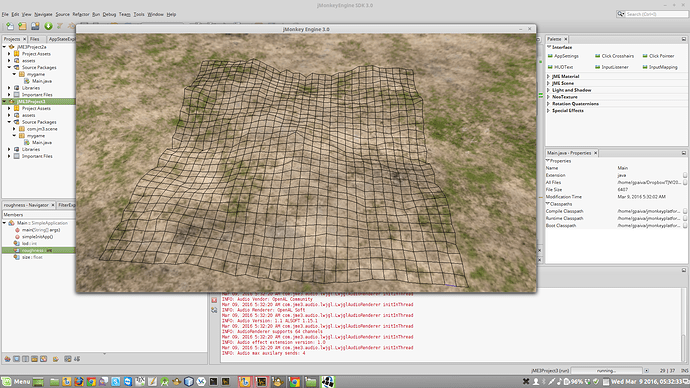Salutations,
I have a code where I implement the diamond square algorithm.
If anyone knows how to address the further described problem please give me a hint/solution.
The code generates and renders the terrain without any problems in newer graphics cards that are in the supported graphics cards specs for developers:
https://wiki.jmonkeyengine.org/doku.php/jme3:requirements
In older cards namely AMD 7000 series.
There is a weird behaviour which is the meshes when rendered overlap and instead of multiple squares I have 1 and also the square(a) fleea with the camera, they literally move. Sometimes I can get a glimpse of them fleeing.
In a more recent supported graphics card
The code responsible for creating the meshes from the heightfield/heightmap is:
ArrayList<ArrayList<Vector3f>> Heightfield;
/**
* This method returns the terrain generated with the diamond square
* algorithm.
*
* @return the last terrain generated with the diamond square algorithm.
*/
public ArrayList<Mesh> getTerrain() {
ArrayList<Mesh> meshesTerrain = new ArrayList<>();
for (int i = 0; i < (Heightfield.size() - 1); i++) {
for (int j = 0; j < (Heightfield.get(i).size() - 1); j++) {
Mesh meshTerrain = new Mesh();
meshTerrain.setMode(Mesh.Mode.Lines);
Vector3f[] verticesTerrain = new Vector3f[5];
int[] indexes = new int[2 * verticesTerrain.length]; //Indexes are in pairs, from a vertex and to a vertex
for (int k = 0; k < verticesTerrain.length - 1; k++) {
indexes[2 * k] = k;
indexes[2 * k + 1] = (k + 1);
}
verticesTerrain[0] = new Vector3f(
Heightfield.get(i).get(j).x,
Heightfield.get(i).get(j).y,
Heightfield.get(i).get(j).z);
verticesTerrain[1] = new Vector3f(
Heightfield.get(i).get(j + 1).x,
Heightfield.get(i).get(j + 1).y,
Heightfield.get(i).get(j + 1).z);
verticesTerrain[2] = new Vector3f(
Heightfield.get(i + 1).get(j + 1).x,
Heightfield.get(i + 1).get(j + 1).y,
Heightfield.get(i + 1).get(j + 1).z);
verticesTerrain[3] = new Vector3f(
Heightfield.get(i + 1).get(j).x,
Heightfield.get(i + 1).get(j).y,
Heightfield.get(i + 1).get(j).z);
verticesTerrain[4] = new Vector3f(
Heightfield.get(i).get(j).x,
Heightfield.get(i).get(j).y,
Heightfield.get(i).get(j).z);
/* Setting the Meshes Buffer */
meshTerrain.setBuffer(VertexBuffer.Type.Position, 3, BufferUtils.createFloatBuffer(verticesTerrain));
meshTerrain.setBuffer(VertexBuffer.Type.Index, 2, BufferUtils.createIntBuffer(indexes));
meshTerrain.updateBound();
meshTerrain.updateCounts();
meshesTerrain.add(meshTerrain);
}
}
return meshesTerrain;
}
To render I do:
ArrayList<Mesh> meshesTerrain = t.getTerrain();
/* Using the Mesh in a Scene */
/**
* We create a com.jme3.scene.Geometry and com.jme3.material.Material
* from our mesh, apply a simple color material to it or perform vertex
* coloring, and attach it to the rootNode to make it appear in the
* scene.
*/
//Using the mesh together with the Unshaded.j3md material.
Material mat = new Material(assetManager, "Common/MatDefs/Misc/Unshaded.j3md");
//activate wireframe
//mat.getAdditionalRenderState().setWireframe(true);
// set the same color for all vertexes
//mat.setBoolean("VertexColor", true);
mat.setColor("Color", ColorRGBA.Red);
for (Mesh m : meshesTerrain) {
Geometry geoTerrain = new Geometry("Terrain", m); // using our custom mesh object
geoTerrain.setMaterial(mat);
geoTerrain.setLocalTranslation(-size / 2, -size / 10, -size / 2);
geoTerrain.updateModelBound();
rootNode.attachChild(geoTerrain);
}
/* Debugging Tip: Culling */
/**
* By default, jME3 optimizes a mesh by “back face culling”, this means
* not drawing the inside. It determines the side of a triangle by the
* order of the vertices: The front face is the face where the vertices
* are specified counter-clockwise. This means for you that, by default,
* your custom mesh is invisible when seen from “behind” or from the
* inside. This may not be a problem, typically this is even intended,
* because it's faster. The player will not look at the inside of most
* things anyway. For example, if your custom mesh is a closed
* polyhedron, or a flat wallpaper-like object, then rendering the back
* faces (the inside of the pillar, the back of the painting, etc) would
* indeed be a waste of resources. In case however that your use case
* requires the back faces be visible, you have two options: If you have
* a very simple scene, you can simply deactivate back face culling for
* this one mesh's material.
*/
mat.getAdditionalRenderState().setFaceCullMode(RenderState.FaceCullMode.Off);
// END OF EXERCISE 2 (Step 2). -----------------------------------------
/**
* add ambient light. Since, ambient light does not in reality exist we
* shall call it god because like ambient light god is everywhere ...
* assuming god exists obviously. If it/he/she does or doesn't exist is
* in the scope of theology not science.
*
*/
AmbientLight god = new AmbientLight(); //because god is light and god is everywere
//got..setDirection(new Vector3f(-10.0f, -20.0f, -10.0f)); // The direction where the light is pointing (-1, -1, -1) and the light position (10, 20, 10)
rootNode.addLight(god);
The expected result in newer cards I get is:
To anyone that reads this post (regardless if you give input or not) best regards.
